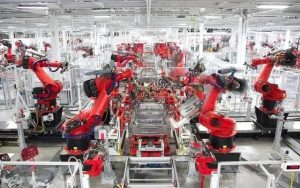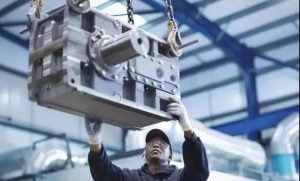
The United States has the world’s second largest manufacturing industry. In 2016, the added value of the manufacturing industry was close to US $ 2 trillion, accounting for about 16% of global manufacturing value added and 12% of US gross domestic product. The United States is the eighth complex economy in the world. However, in the past 20 years, the competitiveness of American-made products has declined and its attractiveness as a manufacturing destination has faced severe challenges. The United States has an advantageous position in shaping the future competition of the manufacturing industry, and has achieved the highest weighted score for manufacturing drivers. It ranks among the top five in terms of driving factors other than sustainable resources and the institutional framework.
The United States is also world-renowned for its innovation capabilities and has a place in the forefront of major developments in emerging technologies in the Fourth Industrial Revolution. In addition, outstanding higher education institutions support the development, attraction, and retention of advanced human resources in the United States. It is worth noting that the United States is currently working to revive manufacturing. In the tax reform at the end of 2017, the United States reduced the corporate tax rate from 35% to 21%, which increased the willingness of enterprises to transfer some production to the United States.
However, policy and regulatory uncertainties related to immigration and free trade agreements remain. As one of the world’s largest carbon emitters, the United States needs to prioritize energy efficiency and sustainability issues.
Japan
At present, Japan has the third largest manufacturing industry in the world. The total value added of manufacturing industry in 2016 exceeded US $ 1 trillion, accounting for nearly 9% of the global manufacturing value added. China, the United States and Japan together account for nearly half of the global manufacturing added value.
Japan has been the most complex economy in the world since 1984. In terms of manufacturing drivers, Japan is particularly prominent in the demand environment, with a mature consumer base, strong corporate activity, and a huge market size. Japan ranks in the top 20 in terms of technological innovation and institutional framework. In 2016, the Japanese government launched the “Social 5.0” strategy, which aims to promote the transformation of manufacturing through emerging technologies, and even achieve social change.
In addition, the Japanese government also proposed a “Connected Industries” plan in 2017 to support industries such as Japanese manufacturing to create new value through the connection of resources, people, technology, organizations, and other social elements.
The challenges facing Japan are mainly related to human capital, including aging populations, shrinking populations, and lower numbers of immigrants than comparable countries. In addition, Japan has room for improvement in terms of sustainable resource drivers.

Germany
Germany has the fourth largest manufacturing industry in the world. In 2016, the total value added of the manufacturing industry reached US $ 775 billion, and its economic complexity ranked third in the world. Germany has a world-renowned tradition of high-quality manufacturing, and more than half of its manufacturing output is exported overseas. Germany ranks first among comprehensive manufacturing drivers and top ten in technology and innovation, human capital, global trade and investment, and demand environment drivers. German educational achievements are outstanding, technical training programs are leading, the quality of the workforce is high, and the ability to innovate is strong.
With the launch of the “Industry 4.0” plan in 2011, Germany is committed to the digitization and interconnection of products, value chains and business models, and vigorously promotes the development of digital manufacturing, becoming one of the leading countries in this field. Globally recognized as one of the pioneers of the Fourth Industrial Revolution, Germany has played a leading role in setting new global industrial standards and regulations.
India
India is the fifth largest manufacturing country in the world. In 2016, the total value added of manufacturing reached US $ 420 billion, ranking 45th in economic complexity. Over the past 30 years, Indian manufacturing has grown at an average annual rate of more than 7%, with average output value accounting for 16% to 20% of GDP. India is the second most populous country in the world and one of the fastest growing economies in the world. The market demand for Indian industrial products is on the rise.
In addition to the top five demand environments, India has plenty of room for improvement in other manufacturing drivers. Human capital and sustainable resources are two key challenges facing India. India’s labor force is relatively young and growing rapidly, but the quality of the labor force needs to be further improved. India should pay attention to measures such as upgrading education courses, improving vocational training programs, and enhancing the digital skills of the workforce.
In addition, as manufacturing continues to expand, India also needs to continue to expand access to energy and reduce emissions. In 2014, the Indian government launched the “Made in India” program, with the main goal of making India a global manufacturing center.
Korea
Over the past few decades, South Korea has experienced significant economic growth, from a backward agricultural society in the 1960s to a manufacturing powerhouse today. South Korea currently has the sixth largest manufacturing industry in the world. In 2016, the total value added of the manufacturing industry exceeded US $ 380 billion, and its economic complexity ranked fourth globally. In addition to its poor performance in sustainable resources, South Korea has generally performed well on other manufacturing drivers.
South Korea is particularly strong in terms of technology and innovation, ranking among the top five in terms of R & D expenditure and patent applications per million people. The outstanding innovation ability has contributed to the historic rise of South Korea and will also help South Korea lead the development of the next generation of production models. In order to strengthen its preparations for shaping the future of manufacturing, South Korea needs to continue to improve its workforce, especially in developing critical thinking skills, digital skills, and advocating knowledge-intensive employment.
In addition, building a sound, transparent, and credible organization can help guide South Korea’s vision for the future of manufacturing and build the trust needed for global connectivity.